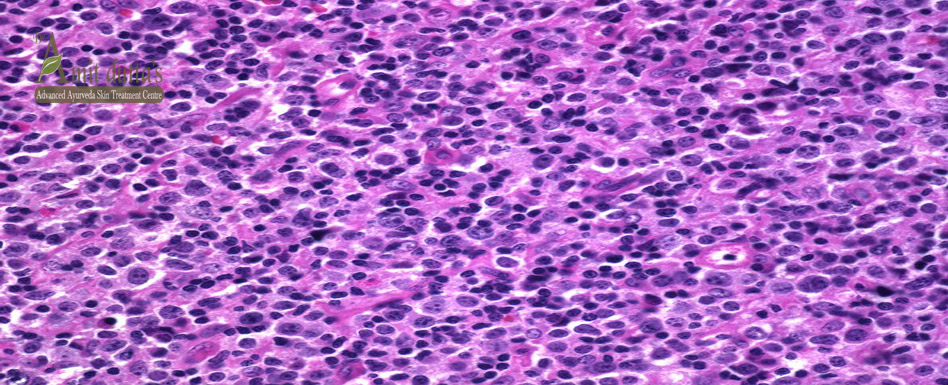
Lymphoma T Cells
CUTANEOUS T-CELL LYMPHOMAS (CTCL)
About CTCL
Tumors of Lymph nodes and Lymphatic system are called Lymphomas.
Extranodal lymphomas are the tumours that occur in organs or tissues outside the lymphatic system.
When lymphomas occur in the skin having no evidence of disease anywhere else at the time of diagnosis , they are called Primary Cutaneous Lymphomas .
There are many types of Primary Cutaneous Lymphomas, but two main categories are Cutaneous T- cell Lymphomas (CTCL) and Cutaneous B-Cell Lymphomas (CBCL). 65% of Cutaneous Lymphomas are T-Cell type.
The diagnosis is made by Skin Biopsy. CTCL is a serious and very uncommon skin condition in which there is an abnormal neoplastic proliferation of lymphocytes with a T- Subtype ( T is Thymus Derived).
CLASSIFICATION OF CTCL
- Mycosis Fungoides – The sub types are
- Folliculotropic MF
- Pagetoid Reticulosis
- Granulomatous Slack skin
- Primary Cutanoeus CD 30 + Lymphoproliferative Disorders
- Primary Cutaneous anaplastic large cell lymphoma
- Lymphomatoid papulosis
- Subcutaneous Panniculitic
- Primary Cutaneous CD4 + small/medium pleomorphic T-Cell Lymphoma, usually presented with a single lesion and progresses slowely.
In Primary Cutaneous Lymphomas, Mycosis Fungicides is the most common types of CTCL in 50 % of cases. The second most common is Primary Cutaneous CD30 + Lymph proliferative disorders.
MYCOSIS FUNGOIDES
The name mycosis is confusing and seems that it is a fungal infection. But it has nothing to with it. It is a condition in which the skin is infiltrated by patches or lumps composed of white cells called lymphocytes. Men are more common to have it than women and very rare in children. The cause of the disease is unknown , in some cases it may be associated with infections with retrovirus or pre-existing contact allergic dermatitis.
Mf may persists in one stage or over the year or sometimes decades , it slowly progress to another stage.
- PATCH STAGE
The lesions are flat in this stage, oval or ring shaped, pink dry patches on covered skin.
They may remain in the same size or slowly enlarge.
The skin may be atrophic , itching may or may not be there.
The differential diagnosis from Psoriasis , Discoid Eczema or ParaPsoriasis is difficult in this stage.
- PLAGUE STAGE
In this stage the patches become thickened and may resembles psoriasis. This stage is usually itchy.
- TUMOUR STAGE
In this stage of Mycosis Fungoides ,the large irregular lumps develop from plagues. Ulceration may occur in the lesions. This is a critical stage where it spread to the other organs . The tumour stage may transform to a large cell lymphoma.
AYURVEDIC VIEW ON CUTANEOUS T-CELL LYMPHOMA (CTCL)
The pathology starts due to the formation of “ama” the toxin produced by the faulty digestion. Poor digestion forms immature “rasa” or chyle . This is the main culprit to develop any disease. In CTCL the dosha becomes disturbed due to the faulty rasa dhatu. All the three doshas gets vitiated and produce their symptoms. Deranged vata produces pain . Deranged pitta produces inflammation and heat. Deranged Kapha produced rigidity.
The imbalances of the dosha causes the “ Rasa vaha Strotas Dushti” , “ Medh vaha strotas Dushti” and “Masma vaha Strotas dushti” and the channels (Srotas ) gets blocked . The proper nutrition doesn’t reach to them due to nutrition deficiency the muscles & skin becomes weak and diseased.
AYURVEDIC TREATMENT FOR CTCL- CUTANEOUS T-CELL LYMPHOMA
- From the above description we gets understand that it’s a diseases not only on the surface of skin but also deep in the tissues and cells of the body i.e. Dhatus and Doshas of the body are also involved in CTCL .
- So CTCL is not EXTERNAL Feature . The “INTERNAL factors causes EXTERNAL manifestations. Only using the medicines locally only relieves the symptoms temporarily.
- To treat the root cause and to get rid from CTCL , it needs a proper diagnosis at the “Dosha Dhatu” level and proper external and internal treatment.
- The First line of treatment is to stop making the “ ama” or toxins which cause the disease.
- Improves the digestive power and corrects the Pitta disorder.
- Lymphatic Detoxification of the body is most important
- Lymphatic Detoxification clears the body from the disease causing factors. It can be achieved by Oral medicines or Panchakarma Therapies.
- Oral Herbal & Ayurvedic Blood Purifying medicines are very helpful to remove the impurities from the blood and it helps to purifies the blood and Lymphatic System.
If you have any query.
You may write us or contact us at –
Mobile: +91-98033-56060, 98030-39369, 0181-2464111
Email : info.ayursudha@gmail.com , ayur.sudha@ymail.com
